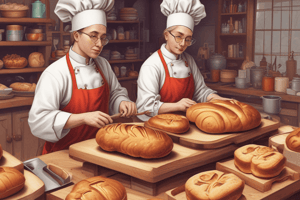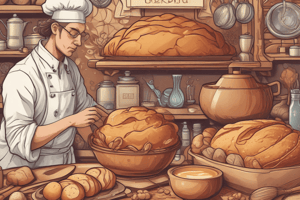Podcast
Questions and Answers
What is the main function of yeast in bread making?
What is the main function of yeast in bread making?
- To strengthen the gluten in the dough
- To ferment and cause the dough to rise (correct)
- To add flavor to the bread
- To control the growth of bacteria
What type of flour is best suited for breads that require strong gluten?
What type of flour is best suited for breads that require strong gluten?
- All-purpose flour
- Cake flour
- Bread flour (correct)
- Whole wheat flour
What is the purpose of autolyse in bread making?
What is the purpose of autolyse in bread making?
- To mix the ingredients thoroughly
- To rest the dough after initial mixing (correct)
- To bake the bread
- To knead the dough by hand
What is the primary function of salt in bread making?
What is the primary function of salt in bread making?
What is the purpose of scoring the dough?
What is the purpose of scoring the dough?
What is the primary function of fat in bread making?
What is the primary function of fat in bread making?
What is the purpose of bulk fermentation in bread making?
What is the purpose of bulk fermentation in bread making?
What is the typical temperature range for baking bread?
What is the typical temperature range for baking bread?
What is a key consideration when choosing a mixer for bread making?
What is a key consideration when choosing a mixer for bread making?
What is a unique feature of retarder-proofers?
What is a unique feature of retarder-proofers?
What is an important feature to consider when selecting an oven for bread making?
What is an important feature to consider when selecting an oven for bread making?
What is a key benefit of using flexible dough scrapers?
What is a key benefit of using flexible dough scrapers?
What is a common feature of planetary mixers?
What is a common feature of planetary mixers?
What is a consideration when selecting a proofer for bread making?
What is a consideration when selecting a proofer for bread making?
What is a key feature of deck ovens?
What is a key feature of deck ovens?
What is a benefit of using rigid dough scrapers?
What is a benefit of using rigid dough scrapers?
Flashcards are hidden until you start studying
Study Notes
Ingredients
- Flour: Provides structure and texture to bread. Types:
- All-purpose flour: Blend of hard and soft wheat flours, suitable for most breads.
- Bread flour: High-protein flour, ideal for breads that require strong gluten.
- Whole wheat flour: Coarser, nuttier flour with more fiber and nutrients.
- Yeast: Responsible for fermentation and rising. Types:
- Active dry yeast: Most common type, needs to be rehydrated before use.
- Instant yeast: Can be added directly to dry ingredients.
- Sourdough starter: Natural yeast culture, requires regular maintenance.
- Salt: Enhances flavor and helps control yeast growth.
- Sugar: Feeds yeast, promotes fermentation.
- Water: Hydrates ingredients, affects dough texture and consistency.
- Fat: Adds flavor, tenderness, and richness. Types:
- Butter
- Oil
- Lard
- Eggs: Adds richness, moisture, and flavor.
- Flavorings: Various herbs, spices, nuts, and seeds can be added for flavor and texture.
Mixing and Kneading
- Mixing: Combining ingredients to form a shaggy dough.
- Kneading: Developing gluten, distributing yeast, and creating a smooth dough. Methods:
- Hand kneading: 10-15 minutes, develops strength and control.
- Stand mixer: Using a dough hook attachment, reduces manual effort.
- Autolyse: Resting the dough after initial mixing, allows flour to absorb water.
Fermentation
- Bulk fermentation: Initial rise, yeast converts sugars into CO2 and ethanol.
- Proofing: Allowing dough to rest and rise before shaping.
- Retardation: Slowing fermentation by refrigerating or freezing dough.
Shaping and Proofing
- Shaping: Forming dough into desired shape and structure.
- Final proof: Allowing shaped dough to rise before baking.
- Scoring: Cutting the dough to control expansion and create decorative patterns.
Baking
- Oven temperature: Typically between 350°F (175°C) and 450°F (230°C).
- Steam: Creates a crispy crust and promotes browning.
- Baking time: Varies depending on bread type and size.
Common Bread Types
- Yeast breads:
- Sandwich bread
- Baguette
- Ciabatta
- Sourdough
- Flatbreads:
- Pita
- Naan
- Focaccia
- Quick breads:
- Banana bread
- Zucchini bread
- Pumpkin bread
Ingredients
- Flour provides structure and texture to bread, with types including:
- All-purpose flour (blend of hard and soft wheat flours)
- Bread flour (high-protein flour for strong gluten)
- Whole wheat flour (coarser, nuttier flour with more fiber and nutrients)
- Yeast is responsible for fermentation and rising, with types including:
- Active dry yeast (needs rehydration before use)
- Instant yeast (can be added directly to dry ingredients)
- Sourdough starter (natural yeast culture requiring regular maintenance)
- Salt enhances flavor and controls yeast growth
- Sugar feeds yeast and promotes fermentation
- Water hydrates ingredients and affects dough texture and consistency
- Fat adds flavor, tenderness, and richness, with types including:
- Butter
- Oil
- Lard
- Eggs add richness, moisture, and flavor
- Flavorings include various herbs, spices, nuts, and seeds for added flavor and texture
Mixing and Kneading
- Mixing combines ingredients to form a shaggy dough
- Kneading develops gluten, distributes yeast, and creates a smooth dough, with methods including:
- Hand kneading (10-15 minutes, develops strength and control)
- Stand mixer (using a dough hook attachment, reduces manual effort)
- Autolyse is a resting period after initial mixing, allowing flour to absorb water
Fermentation
- Bulk fermentation is the initial rise, where yeast converts sugars into CO2 and ethanol
- Proofing allows dough to rest and rise before shaping
- Retardation slows fermentation by refrigerating or freezing dough
Shaping and Proofing
- Shaping forms dough into desired shape and structure
- Final proof allows shaped dough to rise before baking
- Scoring cuts the dough to control expansion and create decorative patterns
Baking
- Oven temperature typically ranges between 350°F (175°C) and 450°F (230°C)
- Steam creates a crispy crust and promotes browning
- Baking time varies depending on bread type and size
Common Bread Types
- Yeast breads include:
- Sandwich bread
- Baguette
- Ciabatta
- Sourdough
- Flatbreads include:
- Pita
- Naan
- Focaccia
- Quick breads include:
- Banana bread
- Zucchini bread
- Pumpkin bread
Mixers
- Stand mixers, like KitchenAid and Hobart, are suitable for small-scale dough mixing
- Spiral mixers are ideal for high-volume dough mixing due to their ability to handle large quantities
- Planetary mixers are versatile and suitable for various dough types, offering a range of mixing options
- Bowl size and material, such as stainless steel, glass, or ceramic, affect the mixer's performance and durability
- Motor power and speed control are crucial for efficient mixing, with varying speeds for different dough types
- Accessories like dough hooks, wire whips, and flat beaters enhance the mixer's functionality
Proofers
- Temperature-controlled proofers maintain precise temperature and humidity for optimal fermentation
- Retarder-proofers slow down fermentation for delayed proofing, allowing for flexibility in production schedules
- Humidity-controlled proofers regulate moisture levels to prevent over-proofing or under-proofing
- Temperature range and control are critical for precise fermentation, with some proofers offering adjustable temperature settings
- Humidity control and monitoring ensure optimal moisture levels for fermentation
- Shelving and basket design affect efficient dough placement and easy cleaning
Ovens
- Deck ovens are ideal for artisanal breads and high-volume production due to their ability to handle large quantities
- Rack ovens offer versatility and are suitable for various bread types, making them a popular choice
- Convection ovens enhance crust coloration and crispiness through controlled air circulation
- Temperature control and precision are essential for even baking, with some ovens offering precise temperature control
- Steam injection or moisture control features enhance crust quality and texture
- Load size and capacity affect the oven's production capability and efficiency
Dough Scrapers
- Flexible dough scrapers with silicone or rubber blades are gentle on dough and ideal for delicate handling
- Rigid dough scrapers with stainless steel or plastic blades are suitable for heavy-duty use and thick dough
- Material and durability affect the scraper's performance and longevity
- Ergonomic handle design ensures comfortable grip and control, reducing fatigue
- Blade shape and size affect the scraper's ability to scrape and handle dough efficiently
Studying That Suits You
Use AI to generate personalized quizzes and flashcards to suit your learning preferences.




